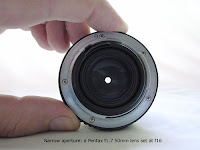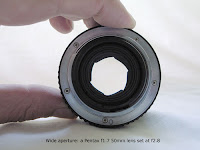Aperture refers to the opening in a lens that lets the light in, and how wide that opening is. Here are some photos to demonstrate:

 The first photo has a narrow aperture, the second has a wide aperture. Some people say "small" and "large" instead of "narrow" and "wide," but that gets a little confusing because of the next fact.
The first photo has a narrow aperture, the second has a wide aperture. Some people say "small" and "large" instead of "narrow" and "wide," but that gets a little confusing because of the next fact.Apertures are given a number, usually with an "f/" in front of the number to denote aperture. The wider the aperture, the smaller the number. The more narrow, the larger the number. (Now you can see why referring to the wide aperture as large is confusing, because it also has the smallest number.) For reference, the first photo is f/16 and the second is f/2.8.
So, I'm already confused...why do I even want to mess with it??
Well, here's what aperture does. First, it works in conjunction with shutter speed (how long the shutter is open) to get a properly exposed photo. But most of all, aperture determines the depth of field (DF), which is the amount of area in a photo that is in focus.
 Here is a photo of Jon that I've taken using a narrow aperture, resulting in a large DF. The aperture was set to f/8.0. My shutter speed was 1/125 of a second. You'll notice that everything in the picture is in focus, from Jon all the way back to the trees.
Here is a photo of Jon that I've taken using a narrow aperture, resulting in a large DF. The aperture was set to f/8.0. My shutter speed was 1/125 of a second. You'll notice that everything in the picture is in focus, from Jon all the way back to the trees. In the next photo, I widened the aperture slightly (to f/5.0). Because a wider aperture allows more light in, I had to use a faster shutter speed of 1/500 of a second. [As a side note, I'm using the "P" setting on my Rebel. It makes sure the image is properly exposed, and I roll the wheel near the shutter button to get the right combination I want. So I just rolled to widen the aperture, and my camera determined the shutter speed. Maybe someday I'll do it all myself, but today is not that day!] Anyway, you'll notice that the elements behind Jon have gotten a little fuzzier. The fountain is a little out of focus, and the trees are too far away to be in focus. They are outside the DF.
In the next photo, I widened the aperture slightly (to f/5.0). Because a wider aperture allows more light in, I had to use a faster shutter speed of 1/500 of a second. [As a side note, I'm using the "P" setting on my Rebel. It makes sure the image is properly exposed, and I roll the wheel near the shutter button to get the right combination I want. So I just rolled to widen the aperture, and my camera determined the shutter speed. Maybe someday I'll do it all myself, but today is not that day!] Anyway, you'll notice that the elements behind Jon have gotten a little fuzzier. The fountain is a little out of focus, and the trees are too far away to be in focus. They are outside the DF. Still not satisfied, I tried once more with an even wider aperture, f/1.8, which is the widest my 50mm lens will go. My camera compensated with a shutter speed of 1/2000. Now I have a much smaller DF. Only Jon is in focus, and the background is pleasantly fuzzy. This is why I like aperture. What had started as a nice shot turns into something that can really pop. The photo almost gets a 3D quality to it. My subject stands out from the background, which is exactly what I want.
Still not satisfied, I tried once more with an even wider aperture, f/1.8, which is the widest my 50mm lens will go. My camera compensated with a shutter speed of 1/2000. Now I have a much smaller DF. Only Jon is in focus, and the background is pleasantly fuzzy. This is why I like aperture. What had started as a nice shot turns into something that can really pop. The photo almost gets a 3D quality to it. My subject stands out from the background, which is exactly what I want.One note of caution, however. While I like working with a shallow DF, it can get me in trouble sometimes, usually when there are two or more subjects in the photo. If the DF is too shallow, only one person may be in focus. You may not be able to see that until you look at the photos on your computer, which means you have to be aware of DF as you shoot, without relying on the playback screen on your camera to tell you if you got the shot.
So, you've got a point and shoot without fancy shmancy lenses? Never fear! My Canon PowerShot A70 (from several years ago), has these settings within the menus. So check your manual and see what you can find!













very interesting! I learned something I didn't expect to learn today...blowing raspberries at a 6 month old all day can really make the brain mushy after a while :) I will check my camera for aperture settings!
ReplyDeleteYou could write a book on this . . . very practical and helpful. Thanks!
ReplyDeleteUgh... this post reminds me that I need to spend some quality time with my new camera. I need something to take pictures of!
ReplyDelete@Karen: You'll have something to take pictures of in about a month!! In the meantime, take shots of baby shoes or something. :)
ReplyDeleteThat's funny! I did a photo shoot with baby shoes already!
ReplyDeleteThat is cool. It almost makes my brother look good!
ReplyDeletethis is great stuff. you explain aperture like a pro only in lay terms.
ReplyDeleteBTW: I was wondering how you got the site meter blog stats counter on your side bar. I cant figure out where to put the code...blogspot keeps telling me it is bad code or if I put it in a "page element" like the HTML it shows up as a link to their page but no ticker...any ideas?
nevermind im a dork. figured it out. *chagrin*
ReplyDelete